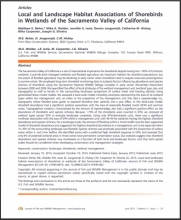Local and Landscape Habitat Associations of Shorebirds in Wetlands of the Sacramento Valley of California

The Sacramento Valley of California is a site of international importance for shorebirds despite having lost >90% of its historic wetlands. Currently both managed wetlands and flooded agriculture are important habitats for shorebird populations, but the extent of flooded agriculture may be declining in early winter when shorebirds need to acquire resources postmigration to survive winter. We employed long-term shorebird monitoring data to evaluate factors influencing abundance and species richness of shorebirds using the Sacramento National Wildlife Refuge Complex in early winter (November–December) between 2000 and 2009. We quantified the effect of local attributes of the wetland management unit (wetland type, size, and topography) as well as factors in the surrounding landscape (proportion of surface water and housing density) using generalized linear mixed models. We assessed a local-scale model, including covariates representing the area of six wetland types within the management unit, an index to the proportion of the management unit that had a tapered-edge (i.e., topography where flooded areas grade to exposed shoreline then upland), and a year effect. In this local-scale model, shorebird abundance had a significant positive association with the area of seasonally flooded marsh (SFM) and summer water. Topographical variation, characterized by the amount of tapered-edge, also had a significant positive effect on the abundance of shorebirds and species richness. Because >70% of the shorebirds were counted in SFM, we removed all wetland types except SFM to evaluate landscape covariates. Using only SFM-dominated units, there was a significant nonlinear association with the area of SFM within a management unit, with 40–95-ha wetlands having the highest shorebird abundance and species richness. On a landscape scale, the amount of flooding within a 10-km buffer was the best supported model of shorebird abundance and suggested the highest shorebird abundance in a management unit to be expected when 15–45% of the surrounding landscape was flooded. Species richness was positively associated with the proportion of surface water within 2- and 5-km buffers. We identified zones with a predicted high shorebird response to SFM, and assessed that only 6% of potential wetland areas in those zones have permanent conservation status. Our analyses suggest that shorebird abundance and species richness vary nonlinearly as a function of both local and landscape factors, and thus both spatial scales should be considered when developing conservation and management strategies.
Reiter, M. E., M. A. Wolder, J. E. Isola, D. Jongsomjit, C. M. Hickey, M. Carpenter, and J. G. Silveira. 2015. Local and Landscape Habitat Associations of Shorebirds in Wetlands of the Sacramento Valley of California. Journal of Fish and Wildlife Management 6:29–43.
